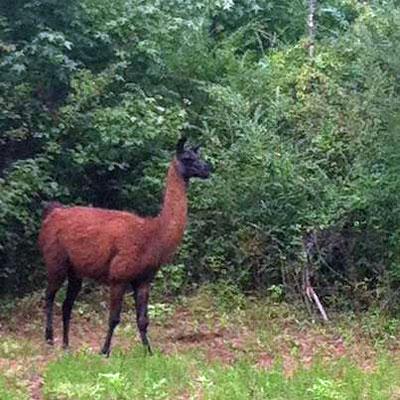Cowpens National Battlefield and the Revolutionary War battle it commemorates are both named for a site associated with the early cattle industry in America. An recent situation at the park created the need to get a four-legged animal into a pen, but in this case it wasn't a cow—it was a llama on the lam.
According to a park spokesperson, "On September 14, 110 fourth graders from Buffalo Elementary School in Union, South Carolina, visited Cowpens National Battlefield and received more than just a history lesson. While it is normal for visitors to encounter wild turkeys, deer, and rabbits when walking the battlefield, it is unprecedented for them to come across a llama. These youngsters, as well as dozens of other visitors over the course of the weekend, spotted this exotic ungulate munching on grass alongside the Tour Road."
The mystery of the llama's origin was solved not far from the park. “George” the llama had sought refuge and fodder in the park when an older, dominant male llama chased him from his pen outside the park’s boundary.
The llama's owner was unable to keep both the young animal and the older male, so park officials began to work with the owner on two problems: finding a new home for George and safely completing a one-llama roundup. George had plenty of food and room to roam and no desire to return to his former home, so that task proved to be a challenge.
After a weekend of unsuccessful attempts to coax and wrangle George from the park, rangers enlisted the services of Kim and Lynette Melton from Southeast Llama Rescue, a non-profit organization that helps find homes for abused, neglected, and unwanted llamas. The group also provides basic care information and mentors to new llama owners.
The llama rescue team knew that llamas have the same basic needs as any other animal, so they arrived in the park on September 17 with their secret weapon: “Coco-Chanel”, a female llama. The team was able to entice George into an enclosure using a combination of food and “Coco,” and then transported him to his new foster home in North Carolina.
“Visitors and staff learned more than we ever thought we would want to know about llama behavior. It was, however, a unique opportunity to make relevant the impacts that unwanted domestic animals such as hogs and llamas can have on park lands and visitors,” Superintendent John Slaughter pointed out.
The park staff kept the public updated on the progress of the rescue efforts through postings at the park Visitor Center and through social media outlets. The park spokesperson noted, "One visitor to the park’s Facebook page commented that maybe the park should change the name to 'Llamapens.'"


 Support Essential Coverage of Essential Places
Support Essential Coverage of Essential Places







Comments
Another "man" hoodwinked by a pretty face!!LOL
In no way can impacts to park lands by a llama be compared to the destruction caused by hogs, or even horses ridden on trails. They have less impact than deer on plant life, and their wear on the ground is equivalent to that of a hiker. Learn more about llamas at http://www.llama.org/history.htm
LlamaLadySG -
I can't speak on behalf of the park superintendent concerning your comment, but it was not my impression that he was equating the damage to park resources by hogs vs. llamas. The recent situation with a llama wandering loose in the park for several days simply offered a "teachable" moment on the impacts of "domestic animals" when they wander loose in a park. I suspect many visitors to this park are from that area, and are aware of the damage caused by hogs, which may be why he used those animals as another example.
Update - George remains alive and well today, living a happy llama life with his herd in North Carolina.